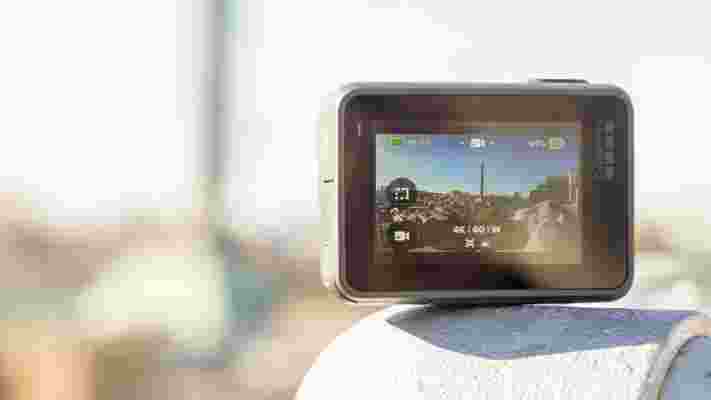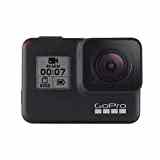GoPro Hero 7 Black review: GoPro’s HyperSmooth video makes the Hero even better
by Miles Warren
April 10,2022
The new GoPro Hero 7 Black is an action camera on a mission to sweep all its rivals before it. Not content with upping the quality a year back with 60fps 4K recording, GoPro is now souping up its electronic stabilisation (EIS) with even better “HyperSmooth” technology.
Indeed, so good is GoPro’s new EIS algorithm that it’s claiming “gimbal-like stabilization without the gimbal”. That’s a bold claim – let’s see if it holds any water.
READ NEXT: GoPro Hero 6 Black review: The best action camera is now a little cheaper
GoPro Hero 7 vs Hero 6 Black: What you need to know
That new stabilisation is, in a nutshell, what sets the new Hero 7 Black action camera apart from its rivals and predecessors, but it isn’t the only new feature.
The Hero 7 Black can also shoot HDR photographs, has improved audio recording quality and the option to live-stream video. The new GoPro can also rotate its UI so you can shoot video in both landscape and portrait mode, making it the perfect tool for the Instagram generation.
READ NEXT: Best action cameras – our pick of the best action cams for 4K recording, running, cycling and more
GoPro Hero 7 Black review: Price and competition
The Hero 7 Black costs £380 and replaces the Hero 6 Black, which has now been discontinued. It isn’t the only 4K action camera on the market, though. There are a few alternatives worth considering, although most can’t match the Hero 7’s feature set.
For recording high-resolution video on a budget, the Yi 4K+ is a great choice, shooting top quality 4K footage at 60fps. It isn't waterproof, though, (you have to add an external case before taking it for a swim) and it can’t record stabilised video at its top resolution and frame rates.

The Sony FDR-X300R offers an impressive combination of OIS and EIS, but it only records 4K at 30fps and it’s more expensive than the GoPro (£520). Finally, there’s the GoPro Hero 5 Black at £270 and the GoPro Hero 7 Silver at £280) . The latter is the cheaper version of the Hero 7 Black – it can shoot 4K at up to 30fps and, although video is stabilised, it doesn’t have the latest “HyperSmooth” stabilisation offered by its more expensive sibling.



GoPro Hero 7 Black review: Design and features
The Hero 7 Black doesn’t look any different from last year’s Hero 6 Black. It’s around the size of a matchbox and the square lens housing still sticks out at the front by a few millimetres.
It might be boring but this is very much a good thing, especially if you use your GoPro in a professional capacity as it’s likely you already own a selection of mounts and accessories. In fact, you can use the GoPro Hero 7 in any accessory dating back to the Hero 5 Black.
As with older GoPro cameras, there are two flaps on the GoPro: one houses the camera’s removable 1,220mAh battery and the microSD card slot, while the other hides a micro-HDMI 2.0 video output and a USB- Type C “supercharger” port that can also be used for data transfers.
The power and shutter buttons are located in the same places – on the left edge and the top plate – and at the rear is a 2in touchscreen, which now works in both landscape and portrait orientations. There’s also a simple monochrome LCD screen at the front, which displays key information such as the mode and the elapsed recording time.
Battery life hasn’t improved since last year’s model, which is a shame. Expect around 70mins of usage when shooting 4K at 60fps with the HyperSmooth stabilisation enabled. According to GoPro, HyperSmooth consumes a bit of battery – so, if you disable it, you'll get a slightly better battery life.
It doesn’t take long to charge, especially with a fast-charger supplied in the box but I’d advise you take a power bank with you while you’re out filming or a few spare batteries.
Unfortunately, there’s also still no tripod thread on the camera body, but the camera is fully waterproof at depths of up to 10m. Being able to chuck the GoPro into a pool and dive, surf and swim with it without having to worry about it dying is a massive bonus. Its rivals, such as the Yi 4K+, need a waterproof case to survive a dunking and this seriously hinders the audio quality when out of the water.
If you need the camera for deeper diving that’s possible, but you’ll need to purchase GoPro’s £50 Super Suit case , which protects the action camera up to a depth of 60m.
READ NEXT: Best power banks in the UK – the top portable chargers you can buy
GoPro Hero 7 Black review: Software and live streaming
The GoPro app (formerly known as Capture) is easy to navigate and use, but connecting it to the camera to update its firmware can be problematic, especially when the camera refuses to acknowledge the phone’s location – this is a requirement before proceeding with the update.
As for wireless connectivity, the GoPro supports both 5GHz and 2.4GHz Wi-Fi. The latter works more consistently. Still, I experienced a lot of problems, to the point where the app would refuse to pick up the Hero 7 Black altogether. And this can be a huge issue if you want to access the camera’s live streaming functionalities.
It’s a shame because, when it works, the app provides an effective means of interacting with the Hero 7 Black. Through it, you can change both video and photo settings, view a live feed from the camera, take a photo, record a video or time lapse and view saved files on the camera’s microSD card. And, once you’ve saved your clips to your phone, you can stitch and edit videos through QuikStories, GoPro’s automatic highlight reel creation tool.
At the time of writing, Facebook and RTMP (Real-Time Messaging Protocol) live streaming are supported. There’s no native support for YouTube or Twitch just yet, but GoPro has promised to support a wider variety of services soon. As for resolution, it goes up to 720p for live streams.
GoPro Hero 7 Black review: Camera interface and touchscreen display
The camera’s interface has also been improved over the GoPro Hero 6. It’s still far from perfect and isn’t as responsive as I’d like, but it’s a step in the right direction.
Using the 2in touchscreen at the rear, you can switch modes (video, photo, timelapse), add digital zoom, change resolution, aspect ratio and frame rate and, by long-pressing on the display, you can enable spot metering and lock the camera’s exposure.
For those requiring more control over colours, sharpening and exposure, ProTune makes a reappearance and allows you to adjust colour, ISO, exposure, and shoot in RAW among other things.
You can also adjust the camera’s settings by swiping down from the homescreen and entering your preferences. Here, you’ll also find four hotkeys that allow you to enable or disable voice commands, beeps, QuikCapture , and auto-rotation.
In the settings menu there’s also the option to enable voice control, useful if you’re riding your bike and want to initiate a recording, capture an image or start a time lapse without having to take your hands off the handlebars. Even better, voice controls also work when the camera is off.
READ NEXT: GoPro Hero 5 Session review: Size doesn’t matter
GoPro Hero 7 Black review: Video & image quality and HyperSmooth
With the GoPro Hero 7, it’s less useful comparing bit rates to other manufacturers’ action cameras, since the GoPro Hero 7 Black reverts to using the more efficient HEVC codec when recording in 4K 60fps. So, while the Yi 4K+ records at up to 135Mbits/sec with H.264, the GoPro Hero 7 Black records at a maximum of 60Mbits/sec with H.265.
The rule of thumb is, roughly, that the HEVC is twice as efficient for the same level of image quality, which would give the GoPro an equivalent bit rate of around 120Mbits/sec, but it’s hard to say precisely what the image quality equivalency is because that’s subjective.
As for resolution, the GoPro can record at up to 4K (3,840 x 2,160) at 60fps, 2.7K at 120fps, 1440p at 120fps and 1080p at a staggering 240fps. Those slow-mo videos have never looked so good.
^ Yi 4K+: 1080p at 120fps
^ GoPro Hero 7 Black: 1080p at 240fps
Video quality is very good. Colours are vibrant, dynamic range is fantastic and I found it difficult to catch out the automatic white balance setting whatever light I was recording in. In the image below, you’ll see a snapshot of the Hero 7’s and Yi 4K+’s video quality at 4K/60fps compared with the Yi 4K+. You can see clearly that the Hero 7 is able to expose for the sky without blowing out the highlights and bring out more detail in areas of shadow.
^ Yi 4K+ (left) vs Hero 7 Black (right) – The Hero 7 Black captures a lot more detail in the shadow of the building’s inner corner, plus there’s a lot less optical distortion
Low-light video performance has improved since the Hero 6 Black and it’s a lot more impressive than the Yi 4K+. In the image below, the Hero 7 Black makes a better stab at capturing a balanced exposure – my face isn’t completely in shadow as it is with the Yi 4K+ – and although image noise hasn’t been totally eliminated, it's acceptable.
^ Left: Yi 4K+; right: Hero 7 Black – front-facing video snapshot in low light conditions
I also put the two cameras to the scrutiny of the Expert Reviews low-light test and, again, the Hero 7 Black comes out on top. In the image below, the GoPro suffers from less image noise and, much like the image above, the Yi 4K+ struggles to portray the scene. Here, the bear is more visible, the train is more distinguishable and the 8-Ball isn't lost in the shadows.
^ Left: Yi 4K+; right: Hero 7 Black – video snapshot in low light conditions
Now, onto video stabilisation, which is the GoPro Hero 7 Black’s marquee feature and for which the manufacturer makes some pretty bold claims. It’s “gimbal-like stabilisation without the gimbal,” says GoPro. I have to say I was sceptical. However, I’ve been blown away by how effective the new HyperSmooth stabilisation is, which has been made possible thanks to the GP1 processing chip and 2GB of RAM.
HyperSmooth is still electronic image stabilisation (EIS), which is unlike some of its competitors that use a combination of EIS and OIS (optical image stabilisation), but the Hero 7 Black does an incredible job. I did ask GoPro if it was possible to upgrade the Hero 6 Black, but, due to its limited RAM, it won't be able to cope with HyperSmooth technology.
At 4K 60fps, the Hero 7 Black looks buttery smooth in comparison to the YI 4K+, but that’s no surprise given that at this frame rate the Yi camera can’t run stabilisation anyway.
^ 4K 60fps: left: Hero 7 Black with HyperSmooth; right: Yi 4K+ EIS disabled
Even with EIS enabled on the Yi action camera (4K 30fps), it can’t keep up with the ultrasmooth footage straight out of the Hero 7 Black. Despite the fact that it only uses EIS and not a combination of OIS and EIS, the Hero 7 Black produces video that very nearly matches what you can get with a handheld, motorised gyroscopic gimbal.
Does it replace a gimbal? No. If you need to shoot smooth, ultra-stable video without wanting to experience any rubberbanding, you’ll need a gimbal as it reproduces a much smoother, completely jitter-free video. Something like the GoPro Karma Grip will provide the levels of stabilisation that an action camera on its own cannot achieve.
In most circumstances, though, the Hero 7 Black’s HyperSmooth technology will suffice and completely trumps the opposition’s efforts. It’s particularly impressive when you combine it with ‘TimeWarp’, GoPro’s super smooth time lapse video recording.
Stills photography is similarly impressive. The camera is capable of capturing 12-megapixel images and its f/2.8 aperture is reasonably bright, but it's the use of HDR here, or “SuperPhoto” as GoPro calls it, that sets the Hero 7 Black above the competition.
^ Left: Hero 7 Black in wide mode and HDR; right: Hero 7 Black in wide mode, only
^ Left: Hero 7 Black in wide mode and HDR; right: Yi 4K+
As for audio quality, the Hero 7 Black has had another upgrade over the Hero 6 Black. Audio now sounds a lot fuller and the camera is capable of capturing low-end frequencies with greater fidelity. It’s a lot better than the Yi 4K+. Positional cues are more accurate and the overall sound quality is more life-like.
Finally, the Hero 7 Black, like its predecessor, has GPS built-in, so with the use of either the Quik app or desktop program, you can add telemetry to your videos. This is excellent for track day in-car recordings.
READ NEXT: Yi 4K+ review: A GoPro Hero6 action camera rival
GoPro Hero 7 Black review: Verdict
It might be a tad pricey, but if you want the very best in video recording quality, the Hero 7 Black is the action camera you want. Its HyperSmooth technology is jaw-dropping, its native waterproofing capabilities are impressive, and the still photograph quality is also stupendously good.
It would be a flawless 5/5 Best Buy if it had a better user interface, longer battery life and more reliable connectivity. But, despite all of that, I can still recommend the Hero 7 Black. It’s sensibly priced for what it offers and, with the new features, it’s the very best action camera you can buy.
